Specializing in atomic physics, muon science, and nuclear hadron physics. Research interests include exotic atoms, muon-catalyzed fusion, strangeness nuclear physics, and superconducting detectors.
Profile
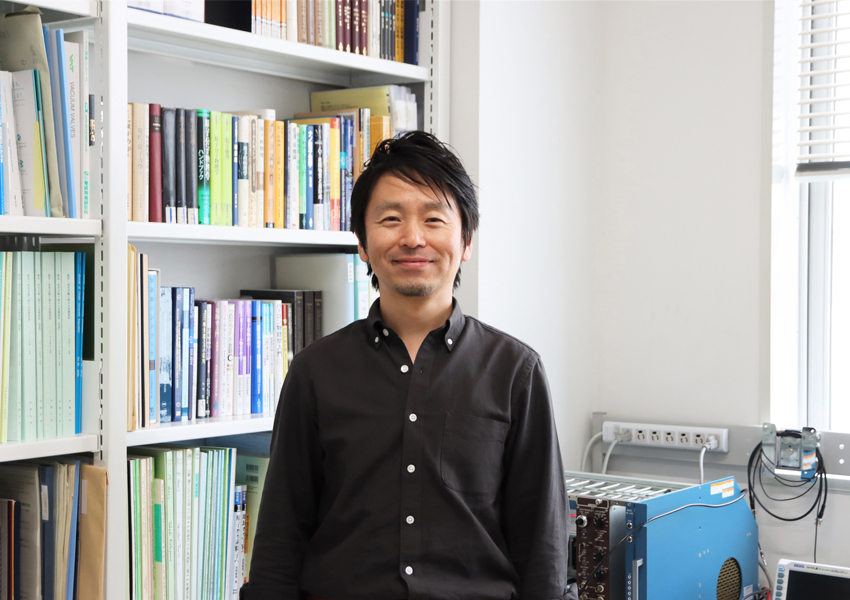
Dr. Shinji Okada holds a Doctor of Science in Fundamental Physics from the Graduate School of Science and Engineering, Tokyo Institute of Technology. He previously worked as a RIKEN Special Postdoctoral Researcher, a postdoctoral fellow at the Frascati National Laboratory of the National Institute of Nuclear Physics (INFN-LNF) in Italy, and a contact researcher at RIKEN. He joined Chubu University in April 2020, and is currently a Professor in the Department of Mathematical and Physical Sciences, College of Science and Engineering. He also holds a position at the Center for Muon Science and Technology.
Born in Tokyo, Japan. Dr. Okada has a wife and two children. On his days off, he enjoys playing musical instruments with his older daughter and playing tennis and other sports with his younger daughter.
Close up with Dr. Okada!
Research Introduction
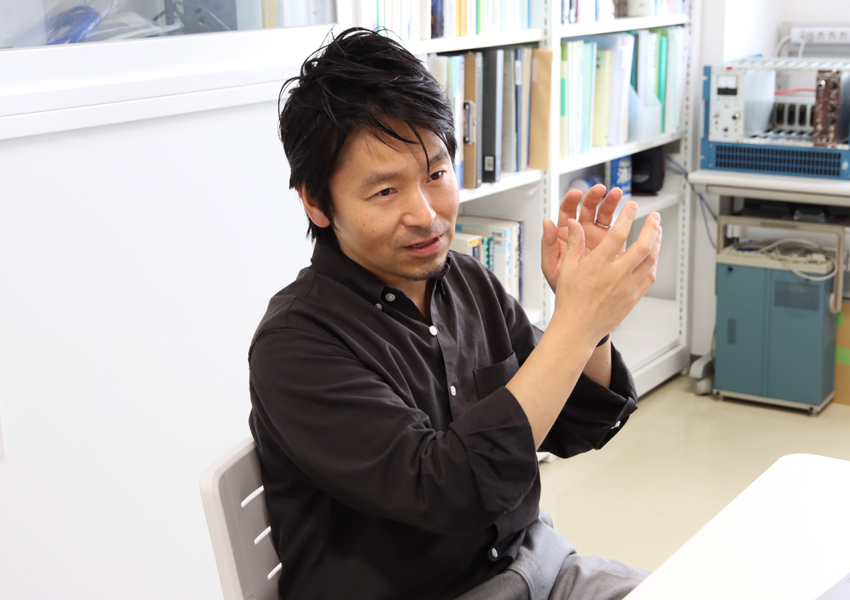
An atom normally consists of one nucleus and several electrons orbiting it. What do you think would happen if one of these electrons were replaced by another particle? I am studying such unusual atoms and molecules, called exotic atoms and molecules, which can be created by using particle accelerators, devices that accelerate particles to near the speed of light and create a high energy state, to produce special particles that are then incorporated into atoms or molecules. I am also studying unusual nuclei (e.g., called hyper nuclei and mesonic nuclei) which are produced by embedding those special particles inside atomic nuclei. These types of research allow us to study the forces between particles, to measure basic quantities such as particle mass and nucleus size, and to induce very specific phenomena. As an example, I would like to explain specifically about the “exotic atoms and molecules” using a particle called “muon.”
Muons are elementary particles that are 200 times heavier than electrons. By replacing one electron in an atom with a muon, it is possible to create an atom that is 200 times smaller than normal. This means that the muon comes extremely close to the nucleus of an atom. By measuring the light (X-rays) emitted during this approach, we can obtain information about the size of the nucleus (charge radius) and the forces between the particles. Similarly, a muon can be used to create a very tiny molecule (a system consisting of a muon and two or more atomic nuclei). In such a molecule, a muon can bring two nuclei closer together than they would normally be able to, and can even trigger a “nuclear fusion reaction,” which is a unique phenomenon that can only occur in ultra-high temperature plasma like the sun.
How did you start your research?
I started my research when I was a senior undergraduate student in the laboratory of my supervisor, Prof. Koji Nakai (currently Professor Emeritus at the High Energy Accelerator Research Organization), where I was exposed to the fascination of accelerator experiments in particle and nuclear physics research. At a research institute called “High Energy Accelerator Research Organization (KEK)” in Tsukuba, Ibaraki, a wide variety of research was actively conducted, including large-scale accelerator experiments conducted by hundreds of researchers, such as the neutrino experiment that led to the Nobel Prize and the B-factory experiment, as well as accelerator experiments conducted by dozens of people. At this institute, I began research on the aforementioned “hyper nucleus,” in which a part of the normal nucleus consisting of protons and neutrons is replaced by another particle (e.g., a Lambda particle). By embedding foreign objects in the nuclei, we were able to examine the contents of nuclei in detail, which would otherwise be difficult to do, and to study the forces acting between nuclei.
After completing my doctoral studies, I shifted to research on exotic atoms at RIKEN. This is a study of “Kaonic atom,” in which a negatively charged particle called Kaon (or K meson) revolves around the nucleus of an atom instead of the usual electron. Precise measurements of X-rays from the atoms allow detailed study of the forces acting between the Kaon and the nucleus. This research is expected to play an important role in understanding the interior of neutron stars that are also called “atomic nuclei floating in space.” For further research, I moved my research base to the Frascati National Institute in Italy, which has the best accelerator for this research, for about four years.
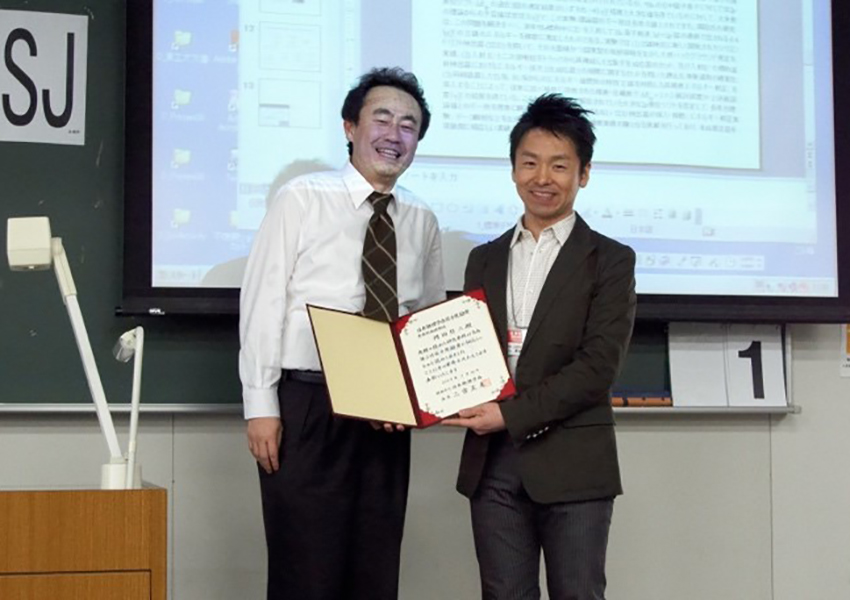
In 2009, Dr. Okada received the “Young Scientist Award of the Physical Society of Japan” for his achievement of precise measurement of the X-ray energy in kaonic helium atoms, which had long been a problem of discrepancy between theory and experiment. (In the photo above, Dr. Okada is on the right and Prof. Hiroyoshi Sakurai, the current Director of RIKEN Nishina Center for Accelerator-based Science, is on the left.)
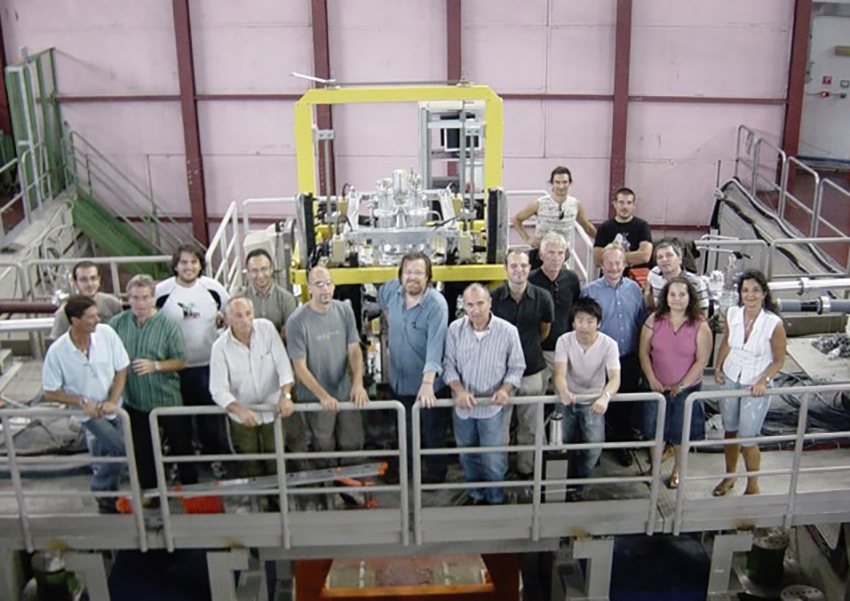
Dr. Okada with colleagues who worked together at the Frascati National Laboratory in Italy (front row, third from the right)
We have recently published two research results and issued press releases titled ” Split second behavior of muons in atoms uncovered for first time” in July 2021, and “High-intensity accelerator and ultra-high-precision thermometer reveal the power to create nuclei – Dramatic improvement in the measurement accuracy of X-rays from exotic atoms” in March 2022.
Let me explain the background on these studies. In experiments on exotic atoms, it is important to accurately measure the energy of the X-rays emitted from the atoms. However, because the beam intensity is limited, the number of exotic atoms that can be produced is not very large, and X-rays from exotic atoms are emitted in all directions, so semiconductor detectors with a large detection area have been widely used. On the other hand, crystal spectrometers are well known as detectors with extremely high energy resolution, but they have the disadvantage of an extremely small detection area. We therefore focused our attention on an array of superconducting transition-edge sensor (TES) microcalorimeters (hereinafter referred to as “TES detector”), an X-ray detector based on cryogenic technology, which has been rapidly developing in recent years. It has an excellent resolution comparable to that of crystal spectrometers, which is one order of magnitude better than the semiconductor detectors that have been the mainstream in X-ray measurements. The detection area can be greatly expanded by using multiple elements to cover a wide energy range. Despite such excellent features, no one has ever used it in a harsh radiation environment such as an accelerator experiment.
Returning from Italy in 2012, my next goal was to bring a breakthrough to exotic atom research, and I formed an international research team with the U.S. National Institute of Standards and Technology (NIST), a world leader in the development of TES detector technology. We are a cross-disciplinary team with researchers not only in nuclear and hadron physics, but also in atomic and molecular physics, as well as in astrophysics, who are involved in TES developments. In 2014, the TES detector was first tested for operation in an accelerator experiment at the Paul Scherrer Institute (PSI) in Switzerland. With the continued acquisition of research grants, we have continued to improve setups with beam test and data analysis methods, enabling us to achieve the excellent energy resolution of TES detectors even in harsh radiation environments. Finally, in 2018, the first kaonic atom experiment using the TES detector was successfully performed at the “Japan Proton Accelerator Research Complex (J-PARC),” a large accelerator facility in Tokai, Ibaraki. After careful analysis, we finally published the result in March 2022 and issued a press release titled “High-intensity accelerator and ultra-high-precision thermometer reveal the power to create nuclei – Dramatic improvement in the measurement accuracy of X-rays from exotic atoms.” I am deeply moved by this achievement, which was achieved through the concerted efforts of researchers from various fields in Japan and abroad over a period of about 10 years since the project was launched.
In conducting the kaonic atom experiment using the TES detector, our research team was the first in the world to obtain advanced measurement technology that led to a breakthrough in accelerator-based X-ray spectroscopy experiments. The power of this detector was quickly demonstrated in an experiment using this measurement technique. The experimental result was published in July 2021, and we issued a press release titled “Split second behavior of muons in atoms uncovered for first time.” This was a serendipitous discovery of a very interesting phenomenon that had not been visible with the previous resolution during a measurement for a different purpose.
Next, we plan to apply this detector to the study of exotic molecules.
Student Life
During my undergraduate years, I played tennis and had a part-time job after classes. After entering graduate school, I immersed myself in research and had the opportunity to participate in various accelerator experiments in Japan and abroad, in addition to my own doctoral thesis experiments. By interacting with many professionals, I was able to solidify my foundation to become an experimental physicist.
Message
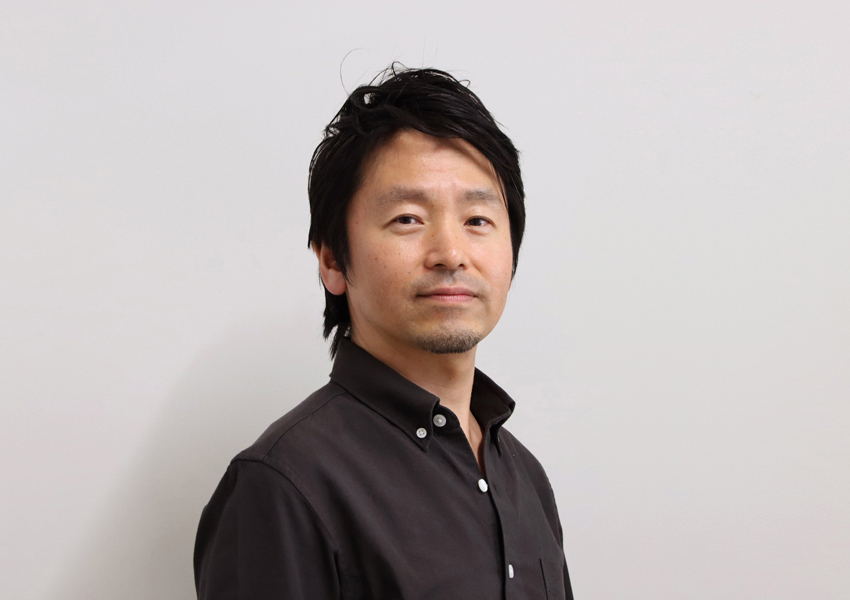
I want you to always keep your antennae open in many different directions, be interested in a variety of things, and thoroughly explore what interests you in particular. Universities provide a wonderful environment where you can easily access to cutting-edge information on a variety of academic fields, but many students often spend their time without realizing the value of such information while they are in school. Chubu University has a wide range of specialists. I encourage you to take advantage of this environment.

